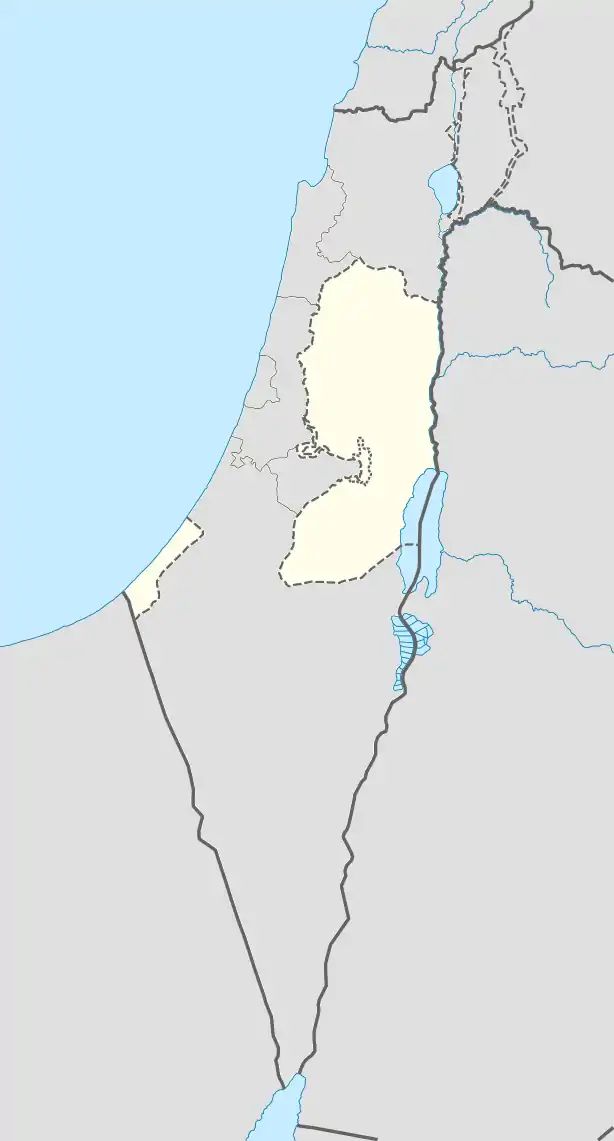 The "Peace on Israel" floor mosaic of the Jericho synagogue. | |
 Shown within State of Palestine | |
| Location | Jericho, West Bank |
|---|---|
| Coordinates | 31°52′27″N 35°26′57″E / 31.874167°N 35.449167°E |
| History | |
| Periods | Byzantine / Talmudic |
| Site notes | |
| Excavation dates | 1936 |
| Condition | Preserved |
| Public access | Restricted |
The Jericho synagogue dates to the late 6th or early 7th century CE and was discovered in Jericho in 1936. All that remains from the ancient prayer house is its mosaic floor, which contains an Aramaic inscription presenting thanks to the synagogue donors, and a well-preserved central medallion with the inscription "Shalom al Israel", meaning "Peace [up]on Israel". This led to the site also being known as Shalom Al Israel Synagogue.
History and description
Discovery
The synagogue, dating from the Byzantine period, was revealed in excavations conducted in 1936 by Dimitri Baramki of the Department of Antiquities under the British Mandate.[1]
The well-off Arab Jerusalemite, Husni Shahwan, who owned the land, built a house on top of the mosaic, careful to preserve it.[2]
Description
The mosaic floor incorporates Jewish symbols such as the Ark of the Covenant, the Temple Menorah, a shofar and a lulav. There is also a Hebrew inscription, "Peace [up]on Israel" (שלום על ישראל), after which the mosaic was named.[3] The phrase "Peace on Israel" has been widely used on Jewish and sometimes Samaritan synagogue floors from the Byzantine and, in one known case, Early Muslim period.[4][5][6][7]
1967–1995
After the 1967 Six-Day War, the site came under Israeli military control and remained under the responsibility of the owners, the Shahwan family.[2] Tourists began visiting the site, as did religious Jews who came regularly for prayers. In the months after the war, Moshe Dayan thanked Mohammed, the son of Husni Shahwan, for the way the family had managed to protect the synagogue remains, which counted among the better preserved in the country.[2] Mohammed Shahwan, who had just lost the bank he had owned due to the war, placed a guard over the mosaic floor and started charging a modest admission fee from visitors for the years until[2][1] 1987, when the First Intifada broke out and the Israeli authorities confiscated the mosaic, the house and a small part of the farm around it.[2] They offered compensation to the Shahwan family, but that was rejected.
After the 1995 Oslo Accords
After the 1995 Oslo Accords, control of the site was given to the Palestinian Authority (PA). It was agreed that free access to the site would continue and it would be adequately protected.[8] The PA has deployed a special security force to protect it.
At the beginning of the Al-Aqsa Intifada the site became a source of conflict. On the night of 12 October 2000, vandals entered and desecrated the building, damaging the private house on top of the ancient mosaic. Later, the PA repaired the damage.[9] The Torah scroll stored at the synagogue was rescued from the fire which had been started and was taken to Mevo'ot Yericho.
In 2005, the synagogue was open to visits, including by Israeli Jews, after the synagogue was restored by the Municipality of Jericho. Such visits, coordinated between the local Palestinian authorities and the Israel Defense Forces, were initially allowed once every month, in order to conduct prayer services.
Since July 2007, Jewish prayer services in the Jericho synagogue have been allowed once every week.[10]
See also
- Wadi Qelt Synagogue
- Naaran, nearby 5th–6th century Jewish village with synagogue ruins (mosaic floor)
- List of oldest synagogues
- Ancient synagogues in Israel (the modern State of Israel)
- Ancient synagogues in Palestine, comprising also West Bank, Gaza Strip, and western Golan Heights
References
- 1 2 - Visiting the City of Jericho, "Jewish Life in Jericho" website by Ari Z. & Yosef N. Zivotofsky, accessed September 2020.
- 1 2 3 4 5 Alpert, Carl (8 December 1967). ""Peace on Israel"". Canadian Jewish Chronicle Review. p. 10. Retrieved 6 September 2020.
- ↑ The lost Jewish presence in Jericho
- ↑ Hachlili, Rachel. "Ancient Mosaic Pavements: Themes, Issues, and Trends", BRILL; mentions Jericho and Huseifa. Accessed 5 September 2020.
- ↑ Eretz Museum website. Mentions the 6th-century Samaritan prayer house from the Eretz Museum grounds. Accessed 5 September 2020.
- ↑ Ein-Gedi is...one of the most important archaeological sites in the Judean Desert. JewishAgency.org. Mentions the Ein Gedi synagogue. Accessed 5 September 2020.
- ↑ Synogogue—In Ramallah?, bridgesforpeace.com, March 1, 2006. Mentions the stolen 7th-century (Early Muslim period) mosaic found in Ramallah and probably coming from the Shuafat-Ramallah area. Accessed 5 September 2020.
- ↑ The Israeli-Palestinian Interim Agreement on the West Bank and Gaza Strip, protocol Concerning Redeployment and Security Arrangements
- ↑ "The Palestinian Authority and the Jewish Holy Sites". JCPA. Archived from the original on 2010-06-21. Retrieved 21 February 2010.
- ↑ "פעם בשבוע תפילה בביה"כ העתיק ביריחו (Once a Week - Prayer at the Ancient Synagogue in Jericho)". Arutz 7 - Israel National News (Hebrew). Retrieved 2015-11-13.
